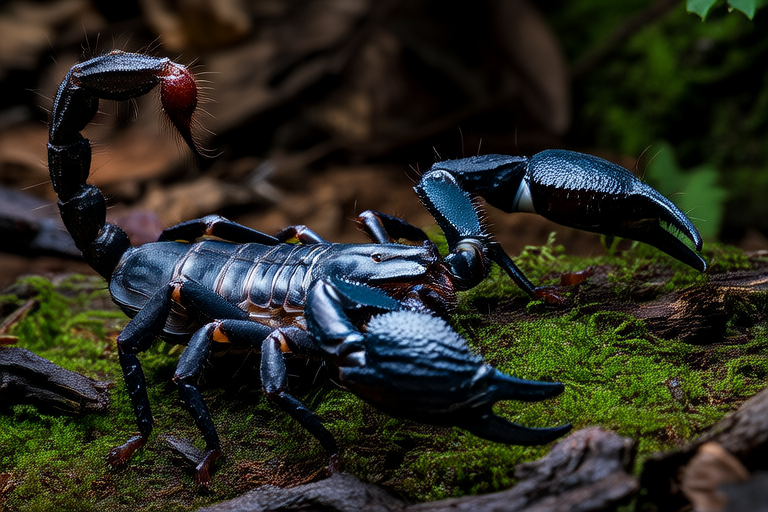Discover the Mysterious Life of Heterometrus Spinifer: From Habitat to Behavior
The world of insects is vast and diverse, filled with creatures that have adapted to various environments and lifestyles. Among these fascinating arthropods, the Heterometrus spinifer stands out as a subject of intrigue. This article delves into the life of this scorpion, exploring its scientific classification, native habitat, physical characteristics, diet, lifecycle, behavior patterns, interactions with humans, conservation status, and unique adaptations.
Scientific Classification
The Heterometrus spinifer, commonly known as the giant burrowing scorpion, belongs to the class Arachnida and the order Scorpiones. It is part of the family Scorpionidae and the genus Heterometrus. The species name ‘spinifer’ refers to the spiny appearance of its tail, which is a distinguishing feature. This classification places it among other scorpions that have evolved over millions of years, showcasing remarkable adaptability to their surroundings.
Native Habitat
Native to Southeast Asia, particularly in countries like Malaysia, Thailand, and Indonesia, the Heterometrus spinifer thrives in tropical rainforests and coastal regions. These areas offer ideal conditions for the scorpion’s survival, characterized by high humidity and temperatures ranging from 24°C to 30°C. The dense vegetation and complex soil structures provide ample hiding spots and burrowing grounds, essential for the scorpion’s secretive lifestyle.
Physical Characteristics
The Heterometrus spinifer boasts an impressive size, reaching lengths of up to 25 centimeters. Its body is segmented into three main parts: the cephalothorax, abdomen, and telson (tail). The cephalothorax houses vital organs and sensory structures, including eyes and pincers. The abdomen, covered in tough exoskeleton plates called tergites, contains respiratory spiracles and reproductive organs. The most striking feature is the telson, equipped with a venomous stinger used for defense and hunting.
Diet
As a nocturnal predator, the Heterometrus spinifer feeds primarily on small insects, spiders, and other invertebrates. Its diet consists mainly of crickets, grasshoppers, and earthworms, which it hunts using its keen sense of touch and smell. The scorpion’s ability to detect vibrations through its legs allows it to locate prey efficiently even in complete darkness. Recent studies suggest that the Heterometrus spinifer may also consume nectar from flowers, indicating a broader dietary range than previously thought.
Lifecycle
The lifecycle of the Heterometrus spinifer begins with mating, which occurs during the dry season when environmental conditions are favorable. Male and female scorpions engage in a complex courtship dance, involving clawing and tail-waving displays. After successful copulation, the female carries fertilized eggs internally for several months before giving birth to live young. Typically, she will produce between 20 and 40 offspring at once. Newborn scorpions remain attached to their mother’s back for about two weeks before dispersing to find their own territories.
Behavior Patterns
Beyond its predatory nature, the Heterometrus spinifer exhibits intriguing behaviors. Known for its burrowing capabilities, this scorpion constructs elaborate underground tunnels that serve multiple purposes. These burrows act as shelters from predators and harsh weather conditions while also providing a secure environment for molting. Additionally, the scorpion demonstrates territoriality, defending its burrow against intruders through aggressive displays and physical confrontations.
Interaction with Humans
Despite its intimidating appearance, encounters between humans and Heterometrus spinifer are relatively rare due to its preference for remote habitats. However, when interactions do occur, they can result in painful stings if provoked. While the venom is potent enough to cause localized pain and swelling, it is generally not lethal to humans. In some cultures, traditional healers use the venom for medicinal purposes, although this practice remains controversial within medical communities.
Conservation Status
The Heterometrus spinifer faces threats from habitat destruction caused by deforestation and urbanization. As human populations expand into previously untouched areas, natural habitats shrink, forcing these scorpions into smaller spaces. Conservation efforts focus on preserving remaining forested areas and promoting sustainable land-use practices. Research initiatives aim to better understand population dynamics and develop effective conservation strategies tailored to protect this species.
Unique Adaptations
One of the most remarkable adaptations of the Heterometrus spinifer is its ability to survive in oxygen-poor environments. By reducing metabolic rates and increasing respiratory efficiency, this scorpion can endure prolonged periods without air. Another adaptation involves the production of antifreeze proteins in its blood, allowing it to withstand colder temperatures more effectively than many other arachnids. These traits highlight the resilience and versatility of the Heterometrus spinifer in adapting to challenging circumstances.
Recent Research and Studies
Scientists continue to explore various aspects of the Heterometrus spinifer‘s biology and ecology. Recent research has uncovered new insights into its chemical communication system, revealing how pheromones play crucial roles in social interactions and mate selection. Genetic studies have shed light on the evolutionary history of this species, tracing its origins back millions of years. Additionally, ongoing projects investigate potential applications of its venom components in drug development, offering promising avenues for future medical advancements.
In conclusion, the Heterometrus spinifer represents a captivating example of nature’s diversity. From its mysterious existence hidden beneath the surface to its interactions with humans and unique adaptations, this scorpion continues to fascinate researchers and enthusiasts alike. Understanding its ecological role and ensuring its survival are vital steps towards preserving the rich tapestry of life on our planet.
